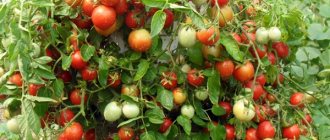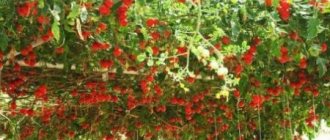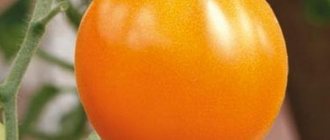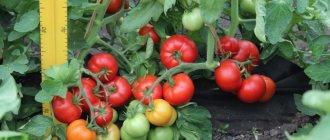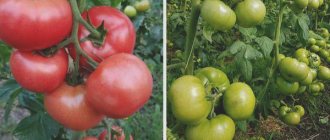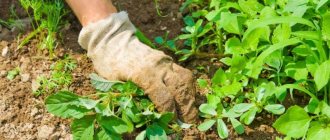Author's rating
Author of the article
Yakov Pavlovich
Professor, Head of the Department of Vegetable Growing
Articles written
153
Among the hybrid tomatoes presented to gardeners, large-fruited, productive varieties are especially loved. The first generation hybrid Krasnobai can be grown not only in protected ground, but also outdoors. Its fruits are fleshy and tasty, and the plant itself is almost not affected by diseases. In the article you can find complete information about the productivity of the Krasnobay tomato, its photos and reviews from gardeners.
The history of the hybrid
The Krasnobay tomato was registered in the State Register in 2008. The copyright holder is the Gavrish company, one of the leading companies among Russian seed producers.
The goal of the breeders was to create a plant suitable for cultivation in greenhouses and outdoors, with numerous and large fruits. Not the least attention was paid to the taste characteristics of the tomato. According to reviews from vegetable growers, biologists coped with the task. Krasnobay is a productive and unpretentious hybrid, with large and tasty fruits.
On a note. The difference between the first generation hybrid (f1) and the variety lies in the best characteristics taken from the parent forms. Hybrid plants are superior to their ancestors in yield and other characteristics. But, the effect of hybridization persists only in one generation, without being transmitted further.
Advantages and disadvantages
The main advantages of the plant include:
- high yield in the greenhouse;
- innate immunity to major tomato diseases;
- large size and excellent taste of fruits;
- long shelf life and good transportability.
Along with the obvious advantages of the Krasnobay hybrid, vegetable growers also note a number of disadvantages:
- the need to form a tomato bush;
- demands on soil fertility;
- the need to annually purchase seeds for sowing.
Krasnobai can be grown in open ground only in the southern regions, since the harvest on the plant is formed quite late.
Main characteristics of tomato Krasnobay F1
The tomato belongs to the mid-late group of varieties, forming ripe fruits 4 months after sowing the seeds. In most of Russia, Krasnobay is placed in greenhouses and greenhouses; only in the south can tomatoes be planted in open ground.
Description of the bush
Krasnobay's bush is powerful, reaching a height of 2.2 m in a greenhouse and over 1.5 m in open ground. The foliage is medium in size and deep green in color. The first fruit cluster is formed after 10-12 true leaves, each subsequent one after 2-3 leaves.
Expert opinion
Stanislav Pavlovich
Gardener with 17 years of experience and our expert
Ask a Question
Attention! To obtain large tomatoes, pinch the top of the plant after forming 8 clusters.
Productivity and taste of fruits
The hybrid is characterized by the formation of a bountiful harvest. In greenhouse conditions, with an intensive growing method, from 1 sq. m harvest 35-40 kg of tomatoes. In open ground, the harvest amount depends on weather conditions and is 6-12 kg per plant.
See also Tomato variety Hundred Poods: description and cultivation features
The tomatoes have a round, slightly flattened shape, large ones with weak ribbing. The color of the skin is scarlet. The standard fruit weight is 270-350 g, the first tomatoes in the cluster reach a weight of 500-600 g.
The tomato pulp is multi-chambered, but tender and juicy. The taste is sweet, rich. The culinary purpose of the hybrid is salad.
Immunity to diseases
Krasnobay is genetically resistant to viral and some fungal diseases: TMV, fusarium and late blight, cladosporiosis.
What conditions does culture require?
Krasnobay needs a high level of soil fertility and a temperature during the growing period, not lower than +20 degrees. The variety is recommended to be placed in film greenhouses or polycarbonate greenhouses, providing regular fertilizing.
In the same greenhouse, it is not recommended to place tomatoes next to cucumbers (the plants need different growing conditions), peppers and eggplants (they have common diseases).
With an intensive growing method, the Krasnobaya bush is formed into 1 stem, cutting off all the stepsons and foliage to the first fruits.
For an uninterrupted supply of water and nutrient solutions directly to the bushes, a drip irrigation system is installed.
Review Reviews
Despite the fact that the type of tomato is still new, it has managed to win the attention of vegetable growers and summer residents, since it is characterized by ultra-early ripening, resistance to bad climatic conditions and excellent taste. And many are captivated by the versatility of the variety, which allows it to be widely used both in cooking and when preparing for the winter.
The variety is not very suitable for cultivation on an industrial scale, since it cannot lie for a long time, maintaining its taste and commercial qualities. Among the disadvantages of the nightshade crop, one should highlight the huge number of seeds in the pulp, as well as high requirements for fertilizing and watering.
Planting and care
Taking into account the late period of fruit ripening, the hybrid is planted as seedlings 60-70 days before planting in the ground. Like all indeterminate tomatoes, Krasnobay is recommended to be grown in individual containers.
Preparatory activities
For seedlings, buy special soil for tomatoes in the store or collect the substrate yourself. For your own mixture, the ingredients are prepared in advance. You will need:
- crumbly non-acidic peat;
- river sand or vermiculite;
- vermicompost or humus;
- soil taken from under trees in a forest or garden.
Before sowing, it is customary to disinfect the soil and enrich it with fertilizers. To get rid of insects, weed seeds and mold spores, pour boiling water over the substrate or roast in the oven for 30 minutes. Complex mineral fertilizer is applied to the cooled soil according to the instructions.
Hybrid branded seeds do not require dressing or treatment with stimulants. They can be sown dry or pre-germinated in a damp cloth.
Timing and patterns of seed sowing
Sowing of late tomatoes begins in February, when planting seedlings in heated greenhouses - in January. Such early sowing forces the seedlings to be provided with additional lighting. Phytolamps are turned on daily, extending daylight hours to 12-14 hours.
The seeds are sown in separate pots (plastic, peat), to a depth of 1 cm. Until the sprouts appear, the tomatoes are kept at a temperature of +25 degrees.
Planting seedlings in the ground and further care
The Krasnobay hybrid is placed in a greenhouse according to a pattern of 40 by 40 cm, in open ground - every 50-60 cm. Rotted manure 1 kg, wood ash 2 tbsp are added to the planting hole. l. It is necessary to install supports for gartering the stems.
Expert opinion
Stanislav Pavlovich
A gardener with 17 years of experience and our expert See also Black tomato Kumato: characteristics and reviews of the variety
Ask a Question
Advice. If the seedlings have stretched out, they are buried down to the first true leaves. The stem is placed lying down in the hole; you can roll it into a spiral.
After planting, the bushes are watered, the soil under them is mulched with straw, crushed bark, and grass. Further care consists of watering, fertilizing, and pruning the shoots.
- Water tall tomatoes 2-3 times a week, keeping the soil moderately moist. Warm water should go directly to the roots without getting on the foliage.
- The hybrid is fed 2 times a month, starting from the 10th day after planting the seedlings in the garden. For intensive cultivation, ready-made mineral mixtures for tomatoes are used; with traditional agricultural technology, an infusion of manure, yeast, weeds, and iodine is used. After flowering, phosphorus-potassium fertilizers are used: ash, superphosphate, potassium sulfate.
- In the greenhouse, all excess vegetation is removed from the tomato. In open ground, 1-2 lower shoots are left on the bush, assigning them the role of additional stems. The crown of the plant is removed after the formation of 5-6 clusters.
The tomato does not need artificial pollination, but to increase the ovaries, it is useful to treat flowering greenhouse plants with the preparation Ovary.
Features of cultivation
The large-fruited hybrid is demanding on soil. If it is acidic, then the beneficial substances will be poorly absorbed, and as a result, blossom end rot of tomatoes will appear.
The holes for Krasnobay are filled with organic and mineral fertilizer. Several liquid foliar and root fertilizing are carried out over the summer. They must be comprehensive and always contain microelements.
The Krasnobay hybrid is grown through seedlings. The tomato does not begin to bear fruit soon, so the seeds should be planted in early February. It is not recommended to use garden soil, as it instantly cakes. A special soil mixture for tomatoes, which can be purchased at any store, is best suited.
The prepared soil is poured into the container. Make indentations about 1 cm. Place the seeds and water with a spray bottle. Cover with a plastic bag.
During cultivation, the air temperature is maintained at about +21°...+23°C. After they germinate, lower the temperature to +18°C. The room is regularly ventilated, but drafts are not allowed.
The first shoots can be seen after five days. Remove the bag, otherwise the tomato sprouts will rot. Subsequent care consists of timely watering and fertilizing. Avoid overmoistening.
The Krasnobai tomato is picked after the appearance of the second true leaf. Transplant into a 500 ml container.
Seedlings must be constantly illuminated, since if there is a lack of lighting, they become very elongated. To stop the growth of the above-ground part and direct all efforts to the development of the root system, it is necessary to spray regularly with the Atlet preparation.
The bed is divided into rectangles. The size of each is 40x60 cm. A hole is made in the center. Pour in some water. When the liquid is completely absorbed, Krasnobay tomato seedlings are planted. Thanks to this preparation, the roots will begin to reach for moisture and begin to develop better.
The soil around the stem is compacted and no longer watered. Mulching is done to retain moisture. The next watering of the tomato is carried out no earlier than three weeks later. Then moisten the soil at intervals of 10 days.
The sprinkling method cannot be used. Water at the root. Otherwise, the inflorescences that appear may fall off. When the first fruits begin to appear, watering is increased. At the same time, the volume of liquid is reduced.
After the procedure, the soil is loosened and weeds are removed. To ensure a bountiful harvest, the stem is tied up in time. After rooting, pinching is carried out. To do this, remove all side shoots from the tomato.
After the first fruits appear, all lower foliage is torn off and all unnecessary brushes that bloom are removed.
The garter is carried out only under the cluster with fruits
Protection from diseases and pests
Greenhouse plants do not require preventive treatments against diseases. They are isolated from external influences; natural immunity is sufficient.
In rainy summers, it is recommended to spray outdoor tomatoes with Fitosporin or a whey solution against fungal diseases.
They cope with harmful insects using a soap solution (from aphids) and biological products: Akarina, Bitoxibacillin, Fitoverma.
Disease Prevention
Despite the high resistance of the Krasnobai variety to diseases, mandatory prevention cannot be ignored, otherwise the tomato may produce a yield lower than declared.
Mandatory procedures include: maintaining proper crop rotation, ventilating the greenhouse, weeding and loosening the soil (or mulching), thinning leaves, watering with manganese, and sprinkling the beds with ash.
To prevent brown spot, you can spray tomatoes with copper oxychloride, and if there are obvious signs of the disease, use special agents (oxychome or foundationazole).
To avoid pest invasion, bushes need to be inspected regularly. Slugs and caterpillars are collected from the leaves by hand, aphids and whiteflies are washed off with a soap solution. To prevent wireworms, the mulch in the garden bed is impregnated with urea.
If the pest infestation becomes serious, it is necessary to use chemicals - insecticides and acaricides.


